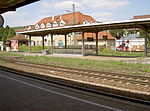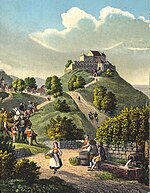Dürrbach (Neckar)
Baden-Württemberg river stubsRivers of Baden-WürttembergRivers of GermanyTributaries of the Neckar
Dürrbach is a river of Baden-Württemberg, Germany. The Dürrbach springs northeast of the district and similar named mountain Frauenkopf of Stuttgart. It is a left tributary of the Neckar in Hedelfingen, a district of Stuttgart.
Excerpt from the Wikipedia article Dürrbach (Neckar) (License: CC BY-SA 3.0, Authors).Dürrbach (Neckar)
Otto-Hirsch-Brücken, Stuttgart Hedelfingen
Geographical coordinates (GPS) Address Nearby Places Show on map
Geographical coordinates (GPS)
| Latitude | Longitude |
|---|---|
| N 48.7617 ° | E 9.258 ° |
Address
Otto-Hirsch-Brücken
Otto-Hirsch-Brücken
70329 Stuttgart, Hedelfingen
Baden-Württemberg, Germany
Open on Google Maps









